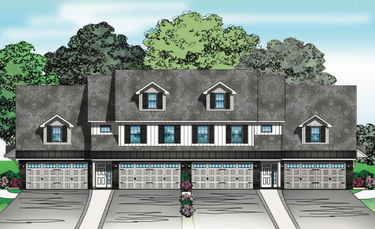Fifty condos proposed for New Scotland Road
NEW SCOTLAND — An oft-changing proposal that spurred New Scotland’s Town Board to clear up its zoning language is back before the town’s planning board.
Initially proposed in June 2021 as a 72-unit apartment project, the plan now for 2080 New Scotland Road is to build 50 condominium units. The project was presented to the New Scotland Planning Board at its March 9 meeting.
The proposal from 13 Blessing LLC is for 12 two-story, four-unit buildings and one two-story, two-unit building. The units would have a mix of two and three bedrooms.
The project narrative says a new 900-foot, 8-inch water main would be installed and turned over to the town, and that a “private sanitary sewer system [would] serve these units.” The project narrative also states “many tenants will be retired or above the age of 50.”
The memo on the project from the town planner notes, “The application as submitted requires waiver from the Hamlet Design Guidelines (driveways in front yard), and three variances (sidewalks on both sides of the street, on street parking, and wetland buffer setbacks).”
The waiver is needed from the town board; the variances would come from the zoning board. The planning board intends on becoming the project’s lead agency.
Richard Long, the site’s owner, first proposed 72 apartments. The issue, in Long’s estimation, was the town’s zoning code wasn’t clear as to allowable density of his proposed development. (The project was later proposed, in August, as a 52-unit condominium project.)
Representatives for Long in June 2021 argued there were different housing standards in the hamlet district: one standard specified only one home per acre while another allowed a residential unit every 3,000 square feet.
Building Inspector Jeremy Cramer had decided that the one-acre zoning applied and allowed Long’s application to move forward to the zoning board, where Long would be able to challenge the one-unit-per-acre determination.
In April 2022, the town board introduced a local law to deal with the issue; it recently adopted the changes.
The New Scotland Hamlet is bounded by the town of Bethlehem to the east, the village of Voorheesville and railroad to the west, the Helderberg-Hudson Rail Trail to the north, and commercial and medium-density residential districts to the south of Route 85.
The proposed development is located in a part of the hamlet known as the expansion area, which is one of three hamlet areas: center, development, and expansion. The new law replaced how base density was calculated, which became an issue with the Long development.
The new law calculates base density in the hamlet district by using net buildable acreage. This clarifies how the base density is calculated for the hamlet districts by first subtracting the environmental constraints on a parcel (like wetlands) before determining how many residential units can be built on the entire parcel.
In all three hamlet subdistricts — the center as well as the expansion and development areas — the proposed law explicitly states 40 total units would be allowed. However, developers would be eligible for a density bonus “in return for providing certain amenities to the town.”
Among the eight amenities (allocated on a point system) that a developer can provide to the town in exchange for additional units — up to a maximum of 10 — is dedicating 25 percent of total units to affordable senior housing; allowing public use of permanently preserved on-site open space; and a number of energy-related provisions.
The 52 condominiums proposed by 13 Blessing LLC led the town planner to write in her memo that the “maximum number of units is above the allowed base density. They are utilizing the density bonus incentive but have no information listed to claim bonus density.”
Kay project
After not building his project to town-approved plans, Ron Kay began to receive approvals piecemeal for his Grove at Maple Point development.
In August, the Route 85A project received a stop-work order for not complying with the plans its developer submitted to the town over a half-decade ago.
A month later, he was OK’d for an already-built 10,665-square-foot building that was about 6.5-percent larger than initially planned. There were also approvals for modifications corresponding to the site, sidewalk, and driveway grade; driveway and road dimensions; and a stormwater plan.
In December, the board approved Kay’s plan to install the foundation for the development’s second building, a 8,250-square-foot structure. And on March 9, Kay received approval for the remainder of the building.
Solar
The town’s first solar facility was on the board’s March agenda because much of its glare protection — its landscaping — no longer exists.
Currently, there are 43 plantings at 331 New Scotland South Road, home to a 1.875-megawatt ground-mounted large-scale solar system; there were originally 122 plantings, said project engineer John Romeo.
The reason the plants died off were two-fold, Romeo said.
The first was that they were planted in soil that was “somewhat” wet; however, they should have been “elevated slightly,” and they were not, Romeo said.
The second reason was the wiring that the plantings came in was removed before they went in the ground, which Romeo said was “no no.”
“It fell apart and there was no chance of survivability,” he said.
A public hearing on the facility was set for the board’s April meeting.



